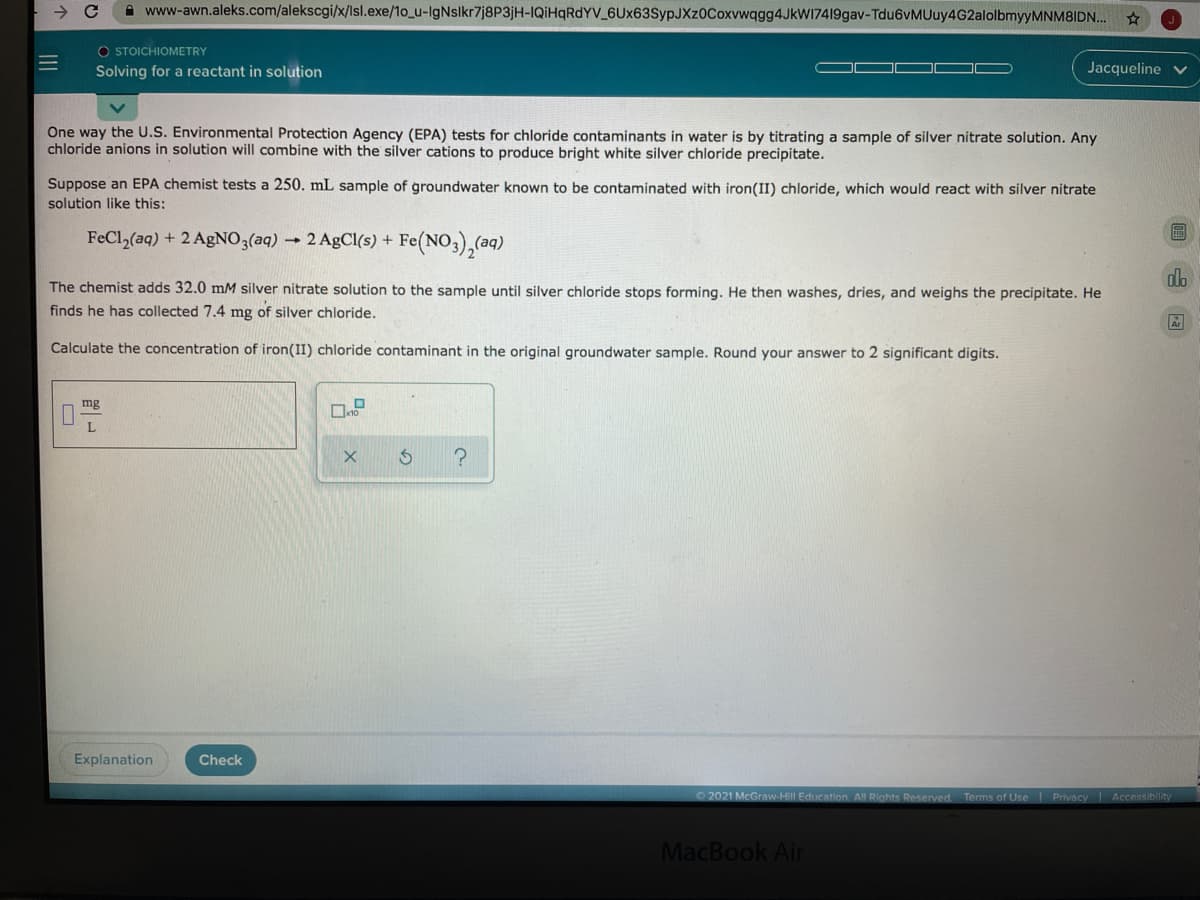One way the U.S. Environmental Protection Agency (EPA) tests for chloride contaminants in water is by titrating a sample of silver nitrate solution. Any chloride anions in solution will combine with the silver cations to produce bright white silver chloride precipitate. Suppose an EPA chemist tests a 250. mL sample of groundwater known to be contaminated with iron(II) chloride, which would react with silver nitrate solution like this: FeCl,(aq) + 2 AgNO3(aq) 2 AgCl(s) + Fe(NO,),(a9) The chemist adds 32.0 mM silver nitrate solution to the sample until silver chloride stops forming. He then washes, dries, and weighs the precipitate. He finds he has collected 7.4 mg of silver chloride. Calculate the concentration of iron(II) chloride contaminant in the original groundwater sample. Round your answer to 2 significant digits. mg
One way the U.S. Environmental Protection Agency (EPA) tests for chloride contaminants in water is by titrating a sample of silver nitrate solution. Any chloride anions in solution will combine with the silver cations to produce bright white silver chloride precipitate. Suppose an EPA chemist tests a 250. mL sample of groundwater known to be contaminated with iron(II) chloride, which would react with silver nitrate solution like this: FeCl,(aq) + 2 AgNO3(aq) 2 AgCl(s) + Fe(NO,),(a9) The chemist adds 32.0 mM silver nitrate solution to the sample until silver chloride stops forming. He then washes, dries, and weighs the precipitate. He finds he has collected 7.4 mg of silver chloride. Calculate the concentration of iron(II) chloride contaminant in the original groundwater sample. Round your answer to 2 significant digits. mg
Chapter8: Sampling, Standardization, And Calibration
Section: Chapter Questions
Problem 8.14QAP
Related questions
Question

Transcribed Image Text:A www-awn.aleks.com/alekscgi/x/lsl.exe/1o_u-IgNslkr7j8P3jH-IQİHQRDYV_6Ux63SypJXz0Coxvwqgg4JkWI7419gav-Tdu6vMUuy4G2alolbmyyMNM8IDN.
O STOICHIOMETRY
Solving for a reactant in solution
Jacqueline v
One way the U.S. Environmental Protection Agency (EPA) tests for chloride contaminants in water is by titrating a sample of silver nitrate solution. Any
chloride anions in solution will combine with the silver cations to produce bright white silver chloride precipitate.
Suppose an EPA chemist tests a 250. mL sample of groundwater known to be contaminated with iron(II) chloride, which would react with silver nitrate
solution like this:
FeCl,(aq) + 2 AgNO3(aq) → 2 AgCl(s) +
Fe(NO,),()
The chemist adds 32.0 mM silver nitrate solution to the sample until silver chloride stops forming. He then washes, dries, and weighs the precipitate. He
finds he has collected 7.4 mg of silver chloride.
Calculate the concentration of iron(II) chloride contaminant in the original groundwater sample. Round your answer to 2 significant digits.
mg
Explanation
Check
2021 McGraw-Hill Education. All Rights Reserved Terms of Use Privacy Accessiblility
MacBook Air
Expert Solution
This question has been solved!
Explore an expertly crafted, step-by-step solution for a thorough understanding of key concepts.
This is a popular solution!
Trending now
This is a popular solution!
Step by step
Solved in 2 steps

Knowledge Booster
Learn more about
Need a deep-dive on the concept behind this application? Look no further. Learn more about this topic, chemistry and related others by exploring similar questions and additional content below.Recommended textbooks for you


Principles of Instrumental Analysis
Chemistry
ISBN:
9781305577213
Author:
Douglas A. Skoog, F. James Holler, Stanley R. Crouch
Publisher:
Cengage Learning


Principles of Instrumental Analysis
Chemistry
ISBN:
9781305577213
Author:
Douglas A. Skoog, F. James Holler, Stanley R. Crouch
Publisher:
Cengage Learning